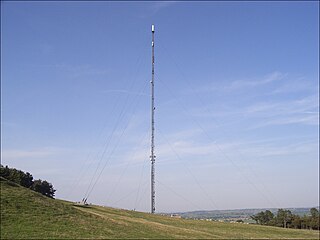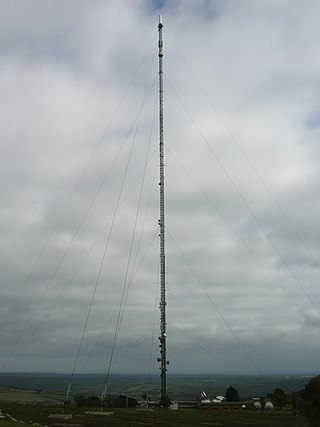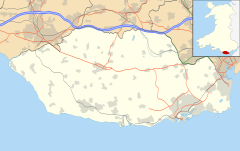The Sutton Coldfield transmitting station is a broadcasting and telecommunications facility located in Sutton Coldfield, Birmingham, England. In terms of population covered, it is the third most important transmitter in the UK, after Crystal Palace in London and Winter Hill near Bolton.

The Mendip transmitting station is a broadcasting and telecommunications facility on the summit of Pen Hill, part of the Mendip Hills range in Somerset, England, at 305 metres (1,001 ft) above sea level. The station is in St Cuthbert Out civil parish, approximately 2 miles (3.2 km) north-east of Wells. Its mast, 293 m (961 ft) high, was built in 1967 and is the tallest structure in South West England. The mast broadcasts digital television, FM analogue radio and DAB digital radio, and had broadcast analogue colour television from 1967 until 2010.

The Caradon Hill transmitting station is a broadcasting and telecommunications facility on Bodmin Moor in the civil parish of Linkinhorne, located on Caradon Hill, Cornwall, England, United Kingdom. It is 4 miles (6.4 km) north of Liskeard, and 3⁄4 mile (1.2 km) south-east of Minions, the highest village in Cornwall. Built in 1961, the station includes a 237.7 metres (780 ft) guyed steel lattice mast. The mean height for the television antennas is 603 metres (1,978 ft) above sea level. The site has a smaller towers used for telecommunications and a wireless internet signal. It is owned and operated by Arqiva.

The Moel-y-Parc transmitting station is situated on Moel y Parc, a hill in north-east Wales at the northern end of the Clwydian range, close to the town of Caerwys and several miles (kilometres) north-east of Denbigh. It was built in 1962/1963 by the IBA to bring 405-line VHF ITV television to North Wales and it has been on the air since 1963. Its original height of 229 metres (751 ft) made it the tallest structure in North Wales and it stands on land that is itself about 335 metres (1,099 ft) above sea level. In 1965, VHF television transmissions from the BBC commenced from the site.

The Rowridge transmitting station is a facility for FM radio and television transmission at Rowridge on the Isle of Wight in southern England.
The Llanddona transmitting station is a broadcasting and telecommunications facility, situated at Llanddona, near Beaumaris, on the isle of Anglesey, Wales. It comprises a 106.7 metres (350 ft) guyed mast with antennas attached at various heights. It is owned and operated by Arqiva.
The Caldbeck transmitting station is a broadcasting and telecommunications facility, situated close to the village of Caldbeck, in Cumbria, England. It is owned and operated by Arqiva.

The Preseli transmitting station is a broadcasting and telecommunications facility on the eastern end of the Preseli Mountains, close to the villages of Crymych and Pentre Galar in Pembrokeshire, Wales. It is owned and operated by Arqiva.
The Oxford transmitting station is a broadcasting and telecommunications facility, situated on land 129.5 metres (425 ft) above Ordnance Datum to the north east of the city of Oxford, in Oxfordshire, England. It has a guyed steel lattice mast which is 154.4 metres (507 ft) in height to the top of the main steel structure. The UHF television antenna, which consist of a vertical array of transmitting panels, is mounted above the steel structure. The total height of the mast to the top of this UHF antenna is 165.7 metres (544 ft). It is owned and operated by Arqiva.
The Black Mountain transmitting station is a broadcasting and telecommunications facility, situated on land 301 metres (988 ft) above Ordnance Datum to the west of the city of Belfast, in Northern Ireland. It includes a guyed steel lattice mast which is 228.6 metres (750 ft) in height. The height of the top of the structure above mean sea level is 529 metres (1,736 ft). It is owned and operated by Arqiva.

The Haverfordwest transmitting station is a broadcasting and telecommunications facility located at Woodstock about 13 km (8 mi) to the north east of the town of Haverfordwest, in Pembrokeshire, Wales. It was originally built by the BBC, entering service in early 1964 acting as a main transmitter for the 405-line VHF television system, and as a repeater for Band 2 VHF FM radio received off-air from Blaenplwyf transmitting station. It is now owned and operated by Arqiva.

Huntshaw Cross transmitting station is a telecommunications facility serving North Devon including the towns of Barnstaple and South Molton. It broadcasts television, radio and mobile telephone services and is currently owned by Arqiva. It is located on the B3232 road at Huntshaw, Great Torrington. Grid reference SS527220. The mast is 164 metres (538 ft) high.

Storeton transmitting station is a television transmitter being a member of both the Winter Hill group of transmitters and of the Moel-y-Parc group of transmitter, and an FM radio transmitter, with transmitting antennas affixed to a mast located on Storeton Ridge, Higher Bebington, Wirral, UK. The site is owned and operated by Arqiva. It was originally solely an analogue TV relay of the Winter Hill transmitter. The 45 metre-high (150 ft-high) mast is situated at an elevation of 65.5 metres (215 ft). Thus, the top of the mast has an overall height of 110.5 metres (363 ft) above sea level. Construction of the mast was completed in 1980. As of 2009, the TV transmitter serves approximately 45,000 homes.

The Blaenplwyf transmitting station is a broadcasting and telecommunications facility located near the village of Blaenplwyf about 10 kilometres (6 mi) to the south west of the town of Aberystwyth, in Ceredigion, Wales. It was originally built by the BBC, entering service in October 1956 acting as a main transmitter for BBC Band II VHF FM radio.

The Kilvey Hill transmitting station was originally built at the summit of Kilvey Hill in Swansea, Wales, by the BBC in 1967 as a relay for VHF and UHF television. VHF television came on air a few months before the UHF services. As built, the station did not radiate VHF FM radio, this was added later. Currently, the hill's transmitters cater for viewers and listeners in the Swansea and Neath Port Talbot area. The transmission station located on top of Kilvey Hill is owned and operated by Arqiva.
The Brecon transmitting station was originally built by the IBA in 1970 as a relay for VHF 405-line analogue television: one of the last 405-line TV stations to be built in Britain. As built, it consisted of a 46 m guyed lattice mast carrying the aerials at the top. This structure was built about 300 m NW of Slwch Tump Iron Age hill fort on the slopes of a 240 m hill known as "The Slwch" overlooking the town. The VHF television feed was provided off-air from Abergavenny, about 25 km to the southeast - itself an off-air relay of St. Hilary near Cardiff.
The Llandrindod Wells transmitting station is a broadcasting and telecommunications facility located on high ground about midway between Llandrindod Wells and Rhayader, in Powys, Wales. It was originally built by the BBC, entering service in 1961 transmitting the now-defunct 405-line VHF television system and the original three FM radio services.
The Llanelli transmitting station is a broadcasting and telecommunications facility located on high ground north of the town of Llanelli, South Wales. It was originally built by the BBC, entering service in mid 1970 transmitting the now-defunct 405-line VHF television system. As such, it was one of the last 405 transmitters ever built.
The Abergavenny transmitting station was originally built by the IBA in 1969 as a relay for BBC and ITV VHF 405-line analogue television. It consists of a 46 m guyed lattice mast carrying the aerials at the top. This structure was built on a 440 m hill known as Gilwern Hill overlooking the towns of Gilwern and Abergavenny in Monmouthshire, South Wales. The band III VHF television feeds were provided off-air from St. Hilary and Wenvoe, both near Cardiff.
The Llanidloes transmitting station is a broadcasting and telecommunications facility consisting of a self-supporting 23 m lattice mast erected on land that is itself about 245 m above sea level about 1 km to the west of the town of Llanidloes in Powys, Wales. It was originally built by the BBC, entering service just before Christmas 1966 transmitting the now-defunct 405-line VHF television system. Transmissions of the original three FM radio services began in February 1967.













